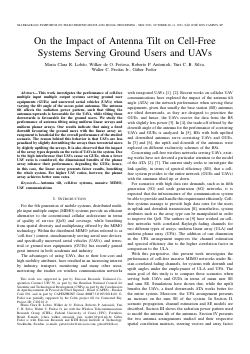
On the Impact of Antenna Tilt on Cell-Free Systems Serving Ground Users and UAVs
Maria Clara R. Lobão, Wilker de O Feitosa, Roberto P. Antonioli, Yuri C. B. Silva, Walter da Cruz Freitas Jr., Gabor Fodor
DOI: 10.14209/sbrt.2023.1570917523
Evento: XLI Simpósio Brasileiro de Telecomunicações e Processamento de Sinais (SBrT2023)
Keywords: Antenna Tilt Cell-free systems Massive MIMO UAV communications
Abstract
This work investigates the performance of cell-free multiple input multiple output systems serving ground user equipments (GUEs) and uncrewed aerial vehicles (UAVs) when varying the tilt angle of the access point antennas. The antenna tilt affects the radiation power pattern, such that tilting the antennas upwards is favourable for the UAVs, while tilting them downwards is favourable for the ground users. We study the performance of antenna tilting using uniform linear arrays and uniform planar arrays. Our results indicate that using a fixed downtilt favouring the ground users with the linear array arrangement is beneficial for the overall performance of the studied scenario. The reason behind this behavior is that UAVs are less penalized by slightly downtilting the arrays than terrestrial users by slightly uptilting the arrays. It is also observed that the impact of the array types depends on the ratio of UAVs in the system. Due to the high interference that UAVs cause on GUEs, when a lower UAV ratio is considered, the dimensional benefits of the planar array enhance their performance, degrading the GUEs; hence, in this case, the linear array presents fairer results, benefiting the whole system. For higher UAV ratios, however, the planar array achieves better sum rates.Download